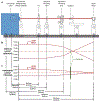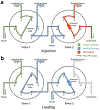Protein higher-order-structure determination by fast photochemical oxidation of proteins and mass spectrometry analysis
- PMID: 33169002
- PMCID: PMC10476649
- DOI: 10.1038/s41596-020-0396-3
Protein higher-order-structure determination by fast photochemical oxidation of proteins and mass spectrometry analysis
Abstract
The higher-order structure (HOS) of proteins plays a critical role in their function; therefore, it is important to our understanding of their function that we have as much information as possible about their three-dimensional structure and how it changes with time. Mass spectrometry (MS) has become an important tool for determining protein HOS owing to its high throughput, mid-to-high spatial resolution, low sample amount requirement and broad compatibility with various protein systems. Modern MS-based protein HOS analysis relies, in part, on footprinting, where a reagent reacts 'to mark' the solvent-accessible surface of the protein, and MS-enabled proteomic analysis locates the modifications to afford a footprint. Fast photochemical oxidation of proteins (FPOP), first introduced in 2005, has become a powerful approach for protein footprinting. Laser-induced hydrogen peroxide photolysis generates hydroxyl radicals that react with solvent-accessible side chains (14 out of 20 amino acid side chains) to fulfill the footprinting. The reaction takes place at sub-milliseconds, faster than most of labeling-induced protein conformational changes, thus enabling a 'snapshot' of protein HOS in solution. As a result, FPOP has been employed in solving several important problems, including mapping epitopes, following protein aggregation, locating small molecule binding, measuring ligand-binding affinity, monitoring protein folding and unfolding and determining hidden conformational changes invisible to other methods. Broader adoption will be promoted by dissemination of the technical details for assembling the FPOP platform and for dealing with the complexities of analyzing FPOP data. In this protocol, we describe the FPOP platform, the conditions for successful footprinting and its examination by mass measurements of the intact protein, the post-labeling sample handling and digestion, the liquid chromatography-tandem MS analysis of the digested sample and the data analysis with Protein Metrics Suite. This protocol is intended not only as a guide for investigators trying to establish an FPOP platform in their own lab but also for those willing to incorporate FPOP as an additional tool in addressing their questions of interest.
Conflict of interest statement
Competing Interests
The authors declare an ongoing collaboration with Protein Metrics in establishing an HDX data processing platform, a topic that is not related to this protocol. The recommendation of using Protein Metrics as preferred data processing software for FPOP data predates the ongoing collaboration.
Figures






Similar articles
-
Mass Spectrometry-Based Fast Photochemical Oxidation of Proteins (FPOP) for Higher Order Structure Characterization.Acc Chem Res. 2018 Mar 20;51(3):736-744. doi: 10.1021/acs.accounts.7b00593. Epub 2018 Feb 16. Acc Chem Res. 2018. PMID: 29450991 Free PMC article. Review.
-
Fast Photochemical Oxidation of Proteins Coupled with Mass Spectrometry.Protein Pept Lett. 2019;26(1):27-34. doi: 10.2174/0929866526666181128124554. Protein Pept Lett. 2019. PMID: 30484399 Free PMC article. Review.
-
Fast photochemical oxidation of proteins (FPOP): A powerful mass spectrometry-based structural proteomics tool.J Biol Chem. 2019 Aug 9;294(32):11969-11979. doi: 10.1074/jbc.REV119.006218. Epub 2019 Jul 1. J Biol Chem. 2019. PMID: 31262727 Free PMC article. Review.
-
Mass Spectrometry-Based Protein Footprinting for Protein Structure Characterization.Acc Chem Res. 2025 Jan 21;58(2):165-176. doi: 10.1021/acs.accounts.4c00545. Epub 2025 Jan 5. Acc Chem Res. 2025. PMID: 39757421
-
Implementing fast photochemical oxidation of proteins (FPOP) as a footprinting approach to solve diverse problems in structural biology.Methods. 2018 Jul 15;144:94-103. doi: 10.1016/j.ymeth.2018.05.016. Epub 2018 May 23. Methods. 2018. PMID: 29800613 Free PMC article. Review.
Cited by
-
Mass Spectrometry-Based Structural Proteomics for Metal Ion/Protein Binding Studies.Biomolecules. 2022 Jan 15;12(1):135. doi: 10.3390/biom12010135. Biomolecules. 2022. PMID: 35053283 Free PMC article. Review.
-
A Novel Platform for Evaluating Dose Rate Effects on Oxidative Damage to Peptides: Toward a High-Throughput Method to Characterize the Mechanisms Underlying the FLASH Effect.Radiat Res. 2023 Dec 1;200(6):523-530. doi: 10.1667/RADE-23-00131.1. Radiat Res. 2023. PMID: 38014573 Free PMC article.
-
Covalent Labeling Automated Data Analysis Platform for High Throughput in R (coADAPTr): A Proteome-Wide Data Analysis Platform for Covalent Labeling Experiments.J Am Soc Mass Spectrom. 2024 Dec 4;35(12):3301-3307. doi: 10.1021/jasms.4c00196. Epub 2024 Oct 2. J Am Soc Mass Spectrom. 2024. PMID: 39356573 Free PMC article.
-
Flash Oxidation (FOX) System: A Novel Laser-Free Fast Photochemical Oxidation Protein Footprinting Platform.J Am Soc Mass Spectrom. 2021 Jul 7;32(7):1601-1609. doi: 10.1021/jasms.0c00471. Epub 2021 Apr 19. J Am Soc Mass Spectrom. 2021. PMID: 33872496 Free PMC article.
-
Structural Investigation of Therapeutic Antibodies Using Hydroxyl Radical Protein Footprinting Methods.Antibodies (Basel). 2022 Nov 14;11(4):71. doi: 10.3390/antib11040071. Antibodies (Basel). 2022. PMID: 36412837 Free PMC article. Review.
References
Publication types
MeSH terms
Substances
Grants and funding
LinkOut - more resources
Full Text Sources
Research Materials
Miscellaneous

